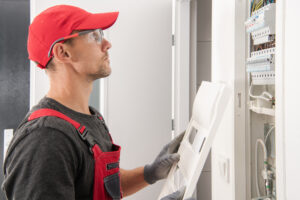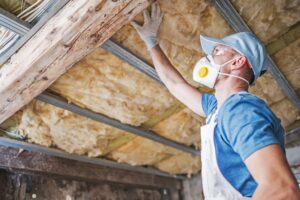Checklist for Winter Home Maintenance
Winterization may appear to be a simple procedure. It is more complicated than you think. Several small things go unacknowledged that could result in your home being damaged and utilities skyrocketing if you don’t take precautions. Winterizing your house entails sealing and protecting it from the elements. It can help you spend less time and money!
Why is winterization home maintenance important? Preparation is one of the best ways to save time and money during cold months. Knowing what you need to do is a simple way to prepare your home for the winter season. The colder it gets outside, the harder your heating system has to work.
In addition, there are often higher prices on certain utilities such as electricity and natural gas during the winter months. This means that you will want to take special precautions to make sure that your system does not break down. When you know what you are doing, it is easy to keep your home protected and prevent damage.
1. Check the Plumbing
The first step is to plan for when the chilly temperatures will arrive in your region. Knowing how long it will take for your water to freeze will help you figure out how many hours a day the temperature will be below 45 degrees. If there’s any time when the temperature may drop lower than 35 degrees, keep your faucets dripping so they don’t freeze up.
- If you know your pipes are going to freeze, turn off the water supply that feeds into them so they don’t burst.
- Ensure all outside faucets are emptied or insulated.
- Make sure any hoses connected to your outside spigots are disconnected and stored inside. If the hose isn’t drained, the water remaining inside may
2. Clean Your Gutters
If you expect a mild winter, you don’t have to be concerned about your gutters. However, if there will be a lot of snow falling from the sky, you should clean them ahead of time. Having your gutters cleaned allows the snow to slide off easily and also removes any leaves that may be clogging them.
- Ensure your downspouts are cleared before the snow begins to fall.
- Be sure to check your gutter guards and remove any that may be damaged or missing altogether.
3. Check Your Insulation
When it begins to get chilly, the first thing that is affected is your doors and windows. If they aren’t properly closed up, they will allow in drafts of air. Knowing where your drafts are can help you figure out how to work around them. Also, find out beforehand where your drafts are so you know how to deal with them.
There are many different ways for heat to enter your home. Because they’re hidden, these sources might not be readily apparent. However, cold air seeps under door thresholds and into attics, crawlspaces, and basements during the winter season (and throughout the year if you live in an area with extreme temperature swings). Because of this, much of your energy bills can be caused by drafts.
This means that you should make sure to seal your doors and windows. You can also insulate them if they are too drafty. It’s important to check the weather stripping on your exterior doors. If it is worn, replace it with new material so that all of the cracks are. Keep your fireplace damper closed when you are not using it.
4. Turn Off Appliances
When you know that it is going to be cold outside, turning off appliances that are not being used can save you quite a bit of money over time! Make sure that you know where any shut-off valves are located, just in case a pipe does burst due to freezing.
5. Prepare Your HVAC System
You should know when the first cold snap is coming so you know how much time you have to get your heating system ready before it hits! The first thing you should know is what kind of heating system you have. There are too many people who guess at what type of system they have and when it gets cold, they don’t know how to adjust their system.
Not only will a wood-burning fireplace give you more time to get it ready before the weather gets chilly, but it also makes for a great focal point. If your hearth is constructed of bricks, make sure it’s fireproof.
If you know you have a fireplace insert, there are fewer things for you to do. You should get the area ready for use and anticipate how long it will take to heat up once it is operational. If this isn’t sufficient, you may want to move on to the next stage before the cold sets in.
Oil furnaces need to know how much oil you have on hand, know if your filter is clean, and know exactly where your thermostat is located at. The last thing you want happening in an emergency is not knowing how to work your heating system!
Natural gas furnaces are the easiest to get ready for winter. You don’t have to know anything about them besides where your thermostat is and if the pilot light is still lit. Some furnace models have special pre-heat functions, so be sure you know what yours is capable of!
The electric heat pump generally just needs the panels and outdoor parts of it cleaned off before winter comes. However, know that some electric heat pumps require a proper shutdown procedure to ensure their components don’t freeze up!
6. Know Where Your Fuse Box Is
You should know where they are located so that if something goes wrong with them, you can replace them or have an electrician repair them for you!
Water heaters, dryers, and furnaces should be checked for fuses. If there is a fuse present, make sure it’s not blown so that you don’t have to go out and get a new one once winter hits!
You can tell if your fuses are blown if they have a broken or melted plastic top. If this is the case, replace them before the cold weather comes. If your plugs are worn out, replace them so that you don’t have to worry about them breaking during a storm!
If something goes wrong with any of your appliances and you’re not sure what to do, check your maintenance manual to see if there are any ice damage precautions or other things that you need to do before using them.
There is usually a fuse located inside the control panel of your appliances, so take these out and bring them with you to the hardware store!
 7. Clear Your Outdoor Areas
7. Clear Your Outdoor Areas
Be sure to clear your outside areas so that snow and ice don’t get stuck underneath anything! If you have an outdoor electrical socket, be certain it cannot be covered in snow. Also remember that if you have a propane tank for your grill, be sure that its cover is secure against the wind!
If you have a snowblower, you’ll want to know where everything is located so that it’s simple to start up. Make sure your generator is well-ventilated and dry. If you have a generator, make sure nothing obstructs the exhaust or intake!
You may use your generator safely if you follow the guidelines in the owner’s handbook. Keep all vents and intakes clear of snow and ice to ensure safe operation.
8. Check The State Of Your Fire Alarms
Smoke alarms can have dead batteries that will not know to let you know when there’s a fire. You know your home better than anyone. Know which rooms smoke alarms are located in and know if they need new batteries. If you know that it is going to be cold outside or suspect that the temperature might drop, new batteries are a must.
You know how long your smoke alarms have been around and know whether they have ever had their batteries changed out or not. If you know the answer to both of these questions is no, know that it’s time to get them changed!
Eco-Friendly Winter-Proofing for Your Home
These are fantastic suggestions for winter-proofing your house, but what are the greenest home systems we can use to be prepared for winter?
Solar-Powered Homes
Solar-powered homes know that they have an eco-friendly system that can also keep them ready for winter. Solar panels are a great way to stay warm in the wintertime. You will never need to change out batteries or worry about insulation. This is one of the most cost-effective ways to know if your house is ready for wintertime.
Eco-Fireplaces
However, know that there are other eco-friendly options out there! Eco-fireplaces are not only energy efficient but you will never need to worry about insulation or changing batteries. These fireplaces can be found in many styles. You can also opt for one of the eco-flame technologies if you know that they will not be running for an extended period.
Wood Stove
If you know that heating bills are high and that you can’t afford solar panels or an eco-fireplace, know that there is always the option to consider a wood stove as well. These stoves don’t need electricity but will need ventilation.
Gas Heat Pumps
You know your budget more than anyone. If these options are not what you can do now, gas heating systems that run on heat pump technology are still a great eco-friendly option. They can still function properly in the coldest temperatures.
In Conclusion
If you feel like you didn’t do enough, remember that winterization is an ongoing process. One check won’t be enough for your home’s winter preparation. Most of your work will be done before the first snow. However, you should continue to make sure your home is winterized even in the summer months.
During the winter, you should have no trouble with your heating system. However, if something does go wrong, the best thing you can do is be ready. Make sure your home is prepared to face whatever mother nature may dish out before anything happens. Keep a list of trustworthy repairmen handy so you’ll know who to call in an emergency.
Remember, as you go through the checklist, it may change things up for you. You will learn different elements of your house and varying needs for your home while doing this. This is only a beginning point in an ever-changing process. Don’t think that if you do something different than what’s on the list that you’re doing it wrong.
You don’t have to do it all at once, what you can do is take one part of this home maintenance list and check off that item. Then add another item and check it off.
Make your list manageable and doable for you and make sure to take care of yourself when you’re completing these tasks! Winterization can be an overwhelming process. However, if done one step at a time, this checklist will help keep you on track and prepare your home for the winter.



